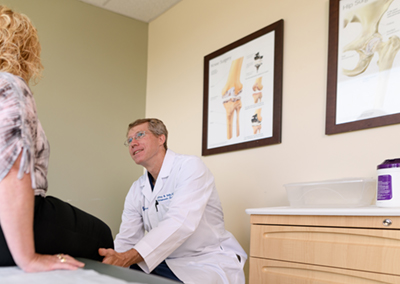Hip and Knee: Comprehensive Treatments

Get the same advanced care for hip and knee disorders as the Division I athletes we treat. We offer modern techniques to help get you back in the game, back to work or back to yourself as quickly as possible.
We do not take a one-size-fits-all approach. Our experts will carefully evaluate you to suggest the best treatment options for your particular needs, including surgical and non-surgical treatments to improve your pain and function and help you enjoy a better quality of life.
Our dedicated team of surgeons, nurses and other health professionals provide seamless care from scheduling through rehabilitation.
For more information, visit our Hip and Knee Treatments Patient Education webpage.
Hip treatments
Hip preservation
You may not need a hip replacement. Several procedures offer relief while keeping your natural hip joint intact.
Arthritis patients who don't need hip replacement surgery can benefit from hip preservation procedures. Hip preservation can relieve pain, restore movement and improve your quality of life – without replacing the joint.
At UK HealthCare, your care is provided by one of only two surgeons in Kentucky specialty-trained in hip preservation. What was traditionally open surgery, we now perform with minimally invasive hip arthroscopy. Learn more about the two main approaches:
Hip arthroscopy
This minimally invasive surgical procedure can repair conditions in the hip joint, including:
- Tears, flaps or worn portions of the cartilage covering the hip joint surfaces.
- Bony protrusions that occur along the rim of the socket or head of the thighbone.
- Femoroacetabular impingement (FAI).
- Joint inflammation (synovitis)
- “Snapping hip” syndromes.
- Ligamentum teres rupture.
- Early arthritis.
How hip arthroscopy works
In hip arthroscopy, the surgeon makes two or three small incisions in the hip area. A flexible, pencil-thick tube (an arthroscope) with a small video camera is inserted through one of the incisions. The arthroscope gives surgeons an “inside look” at the hip joint on large monitors in the operating room. Precise surgical tools are inserted through another small incision, according to the joint problem being addressed.
The surgeon may:
- Shave away or remove flaps or frayed portions of articular cartilage (early arthritis) in a process called debridement or chondroplasty.
- Debride torn cartilage, labral tears or synovitis.
- Place “suture anchors” in the bone of the hip socket to fix labral tears.
- Remove abnormal bone protrusions in cases of femoroacetabular impingement.
- Drill small holes into flat, bony hip areas (called microfracture) to encourage new cartilage to grow where articular cartilage has been lost.
Hip arthroscopy is usually done under general anesthesia (where you’re asleep and won’t feel any pain during the procedure). The surgery usually lasts two to four hours, but can vary depending on the problem being treated. It’s often done as an outpatient procedure, where you go home the same day, but some people need to stay in the hospital overnight.
Surgical hip dislocation
In this open surgery, we separate the hipbone from the thighbone (the ball-and-socket hip joint) for repair. It is most effective for major hip deformities that may not be adequately corrected with hip arthroscopy.
Surgical hip dislocation is more common for younger patients who have a relatively healthy hip with a specific condition. It can be an extremely effective way to correct complex hip disorders while preserving your natural hip joint.
Hip replacement
If your arthritis is advanced, you may need a hip replacement.
Hip revision
If an earlier hip implant has failed or worn down, you may need hip revision surgery.
Trochanteric bursectomy
If you have hip bursitis (trochanteric bursitis), arthroscopic removal of the bursa in the hip may be an option. This minimally invasive surgery can relieve pain and improve movement for trochanteric bursitis that is not relieved by NSAIDs (nonsteroidal anti-inflammatory drugs), ice, physical therapy or cortisone injections.
A bursa is a closed, fluid-filled sac that works as a cushion and gliding surface to reduce friction between tissues of joints, such as the knee and hip joints. Bursitis is inflammation of a bursa. The trochanteric bursa is located on the side of the hip, separated significantly from the actual hip joint by tissue and bone.
Hip bursitis, is often the result of injury, overuse, spinal abnormalities, arthritis or surgery. It is more common in women and middle-aged or older adults.
Knee treatments
Knee arthroscopy
This minimally invasive surgery helps repair different problems with knee joints.
Knee replacement
If your knee is severely damaged, you may need a partial or total knee replacement.
Knee revision
If an earlier knee implant has failed or worn down, you may need a knee revision surgery.
Exercises recommended prior to surgery
Physical therapy
Physical therapy alone may help improve some hip and knee problems. It’s also used before and after surgery to help strengthen you, restore your range of motion and relieve pain.
Physical therapy after a hip preservation surgery can help restore range of motion and relieve pain. Your therapist will work with you and your doctor to create a plan that’s right for you.
Choose one of our three convenient physical therapy locations:
- Albert B Chandler Hospital-Pavilion A.
- Kentucky Clinic.
- UK Good Samaritan Medical Office Building.
In-patient rehabilitation and sports rehabilitation are available when needed.
